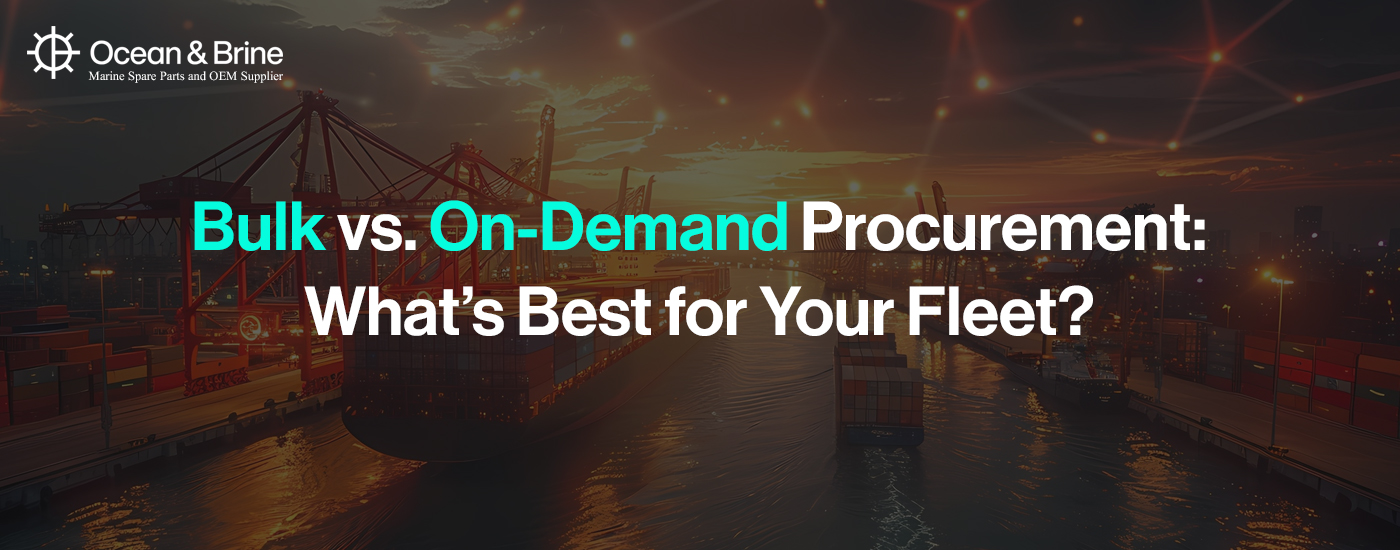Optimize Procurement, Reduce Downtime, and Stay Competitive!
Efficiency in marine spare parts procurement in global shipping is critical. The choice between bulk and on-demand purchasing impacts not only your operational continuity but also profitability and resilience in the maritime industry. This blog helps shipping fleet managers, procurement officers, and marine engineers choose the right strategy, or a blend of both.
First, let us understand what bulk procurement is. Bulk Marine Spare Parts procurement purchases large quantities of goods in advance for future use. This type of hoarding or buying is mostly suitable for commonly used consumables, on established shipping routes, and fleets with a port-based storage facility.
There are several advantages to bulk procurement. Some of them are;
- This lowers the per-unit cost
- The frequency of procurement is minimized and hence reduces costs
- Spare parts are always available on board or in ports
- Seamless operations and minimized repair and maintenance delays, keeping vessels operational
- Protect against market shortages, long lead times, or disruptions at sea
- Larger, planned orders improve supplier responsiveness and access to preferred pricing or service agreements
- Useful for fleets using standardized engines and systems, allowing for uniform part stocking across vessels
Bulk procurement has some disadvantages, too. Here are some:
- Substantial investment is needed upfront, which may strain cash flow, especially for smaller operators
- Requires adequate storage onboard and/or in port warehouses, which can be limited and costly
- Continuous technology upgrades or vessel changes lead to stored spares becoming obsolete or incompatible
- Requires a strong inventory management system to track, rotate, and audit stock to prevent expiration, corrosion, or duplication
- While seemingly advantageous of having storage, distributing spares from central storage to vessels across different ports can lead to delays or misalignment
Now we look at what on-demand spare parts procurement is. On-demand procurement is a purchasing strategy where marine spares and equipment are ordered only when they are needed, rather than being stocked in advance. This approach relies on just-in-time logistics and assumes access to a reliable and responsive supply chain. This leads to ordering engine parts, safety equipment, consumables, or technical supplies based on current vessel requirements, port schedules, or maintenance plans.
A look at some of the advantages of on-demand procurement:
- On-demand procurement reduces the need for large upfront investments—capital is only spent when a part is required
- Minimizes or eliminates the need for warehousing, both onboard and in ports
- Prevents overstocking or obsolescence of parts due to changes in vessel technology or fleet upgrades
- Supports dynamic fleet operations with changing routes or vessel assignments—no need to commit to fixed inventory
- Avoids regulatory issues related to stockpiled hazardous or expiring materials (e.g., chemicals or batteries)
Here are a few disadvantages:
- Lacks the volume discounts associated with bulk purchases, resulting in a higher per-unit cost
- Supply chain disruptions or customs delays can cause critical part shortages and vessel downtime
- Frequent orders increase the workload for procurement and logistics teams (e.g., documentation, customs coordination, supplier negotiations)
- Immediate availability of parts may be limited in remote or less-developed ports, potentially requiring emergency logistics (with high costs)
Comparison table for bulk and on-demand procurement
| Feature | Bulk Procurement | On-Demand Procurement |
|---|---|---|
| Cost Per Unit | Lower | Higher |
| Cash Flow Impact | High upfront spend | Spread over time |
| Inventory Requirements | High | Low |
| Flexibility | Lower | Higher |
| Supply Risk | Low | Higher |
What is the best option for your fleet?
Here are two checklists that you can go through and see which type of procurement is the best for your fleet. Decide based on the number of checks in each list. Which ever list has the most number, that type could be your type.
Bulk procurement checklist:
- We have warehouse/storage access at key ports
- Our vessels use standardized, high-turnover parts
- We operate on predictable shipping routes
What is the best option for your fleet?
- Our supplier network is reliable and international
- Cash flow constraints are minimal
On-demand procurement checklist:
- We handle specialized cargo or operate varied vessels
- We often reroute or change port schedules
- We work with tight or fluctuating budgets
- We use niche or rapidly evolving equipment
- We cannot afford overstock or expired items
Deciding on which procurement is best for your fleet, is a difficult task. However, reviewing data regularly, studying the downtimes, the immediate needs, dependency on logistics, and global operations, a combination of bulk and on-demand could be a wiser option.
